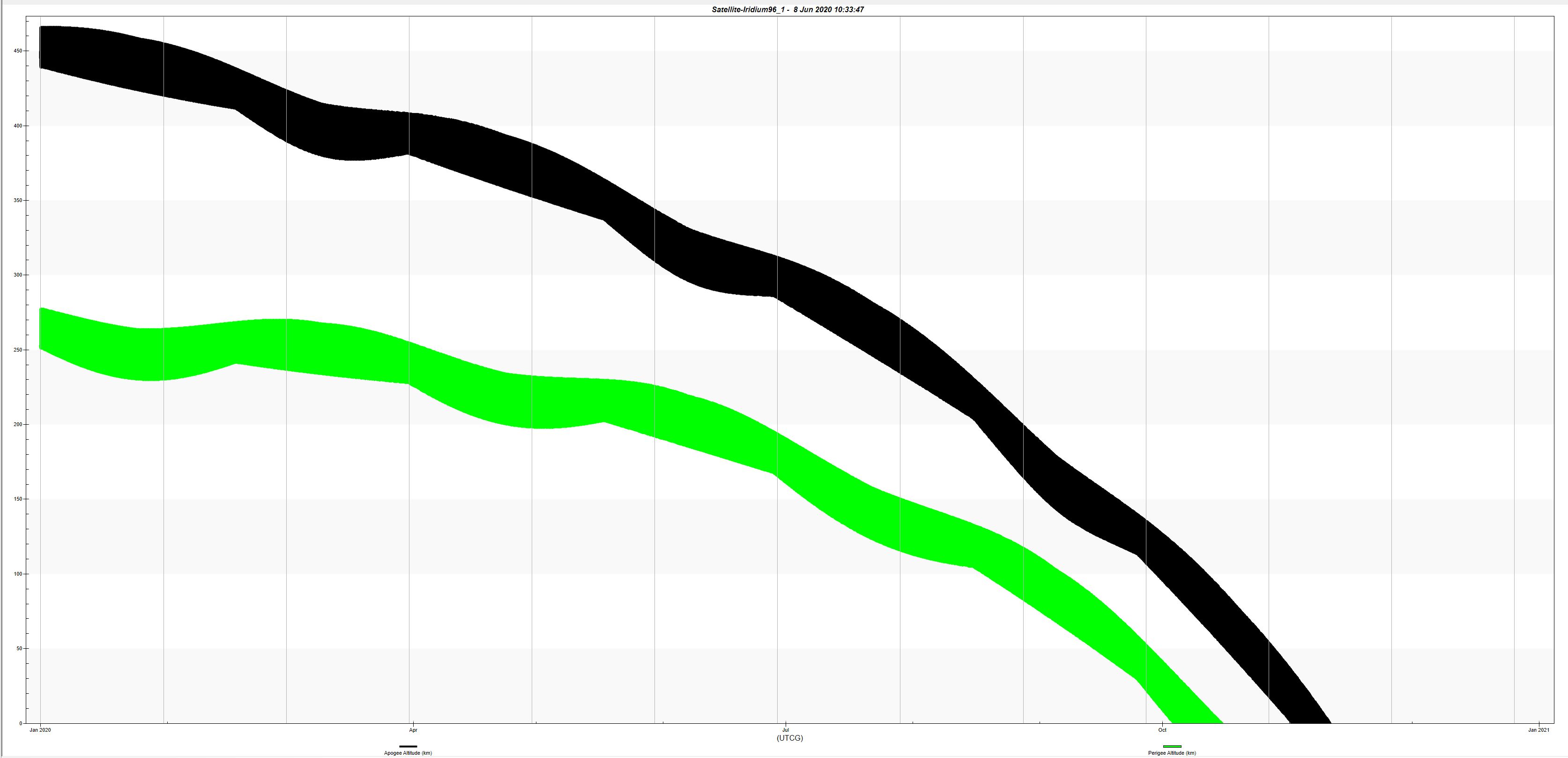The lifetime of any resident space object is difficult to predict. The difficulty stems from the dependence on the atmospheric drag analysis, which includes calculation of density profiles, solar flux, atmosphere, vehicle mass, surface area relative to the atmosphere and to the Sun, unknown/uncontrolled attitude, and more. All of these factors affect how and when the satellite will deorbit.
You should not use the
TLEs with the
SPG4 propagator for lifetime predictions. Instead, you should use higher-accuracy propagators like the
Long-term Orbit Predictor (LOP) or the
High-Precision Orbit Propagator (HPOP). Both the LOP and HPOP propagators take additional effects into account in the orbit propagation, including drag models and atmospheric density models. HPOP also includes solar radiation propagation (SRP) models and high-accuracy gravity models. The LOP propagator is best used for long-duration analysis (months and years), while HPOP is best for shorter durations.
Comparison of using one TLE versus many TLEs to propagate a deorbiting satelliteFirst, consider the orbit predictions using just TLEs for a satellite that was decaying and then deorbited. The Iridium 96 satellite reentered on May 30, 2020. In the image below, the black and green lines are apogee and perigee of the orbit solution using only the TLE from January 1
, 2020. The blue and purple are the apogee and perigee data for the solution that used every TLE update from January to June. For this six-month period, you can see deviations of the two solutions. The most striking part is the large deviation in April and May. This is when the drag was the highest and the reentry occurred. The satellite reenters in late May, as seen in the sharp drop-off. Yet the other solution from the January 1 TLE predicts that the satellite would have continued to remain in orbit.
IRIDIUM 96 (ID 27376)
Launched: Feb 11, 2002
Reentered: MAY 30, 2020 06:17 UTC ± 1 HOUR
As you can see, the SGP4 propagator cannot handle reentry prediction. Looking at the image below, you can see the January 1 TLE propagated until it reaches 0 km. Using this TLE, the propagator predicts this will not happen until Oct 2020, five months after the actual reentry took place. At lower altitudes, the drag is too high for the satellite to remain in orbit. The SGP4 propagator does not capture this. At a threshold of about 80 km, the force of drag is so high that the object is slowed rapidly and falls down to Earth. Higher-fidelity models like HPOP can show that high-drag force affecting the motion.
 How to predict deorbit with STK
How to predict deorbit with STKYou now see that using a TLE with the SGP4 propagator is not the best path to predict reentry. Is there a better option? As mentioned earlier, you should perform Lifetime predictions using higher-accuracy propagators like LOP and HPOP. The best way to get a prediction of the deorbit is by repeatedly tracking the satellite. These observations are then processed in orbit determination tools like AGI's
Orbit Determination Tool Kit (ODTK). Tracking the object will provide a higher-accuracy orbit solution, with better modeling of drag and atmospheric effects. With a higher-quality solution, you can get a better lifetime prediction. The best reentry prediction solution you can achieve using repeated tracking of an object is about a one-rev window, or about +/- 90 minutes. You can only achieve this best solution a matter of days before the reentry event.
Space Situational Awareness (SSA) centers or satellite operators will use the LOP to predict approximately when the vehicle will reenter. Once the time of reentry gets within 60 to 45 days, they will switch to HPOP for the predictions. They track the satellite often to get a better solution and update their prediction with every pass. They process these observations in orbit determination tools like ODTK. They monitor the satellite until they know that reentry has occurred. They know the reentry occurred when they cannot track the satellite on the next expected pass. The satellite is a “no show,” indicating that the vehicle reentered. AGI's ODTK and
ComSpoC's SSA Software Suite include these propagators and additional capability for higher-accuracy reentry analysis.
Where do I get started calculating orbit decay in STK?Learn how to use the Lifetime Tool to calculate and estimate the duration of time that a satellite will remain in orbit using this tutorial:
Basic Satellite Design in STK Using SatProHere is how to use the Lifetime Tool in STK:
Using Satellite Lifetime Tool and HPOP to Predict Satellite DecayHere is a code example of how to take a TLE and then use STK's
Astrogator capability with HPOP to predict the decay estimation:
Satellite Deorbit Estimation Using Astrogator from a TLETo see how to set up your own large-scale orbital lifetime analysis, check out
this blog and the
example code.

